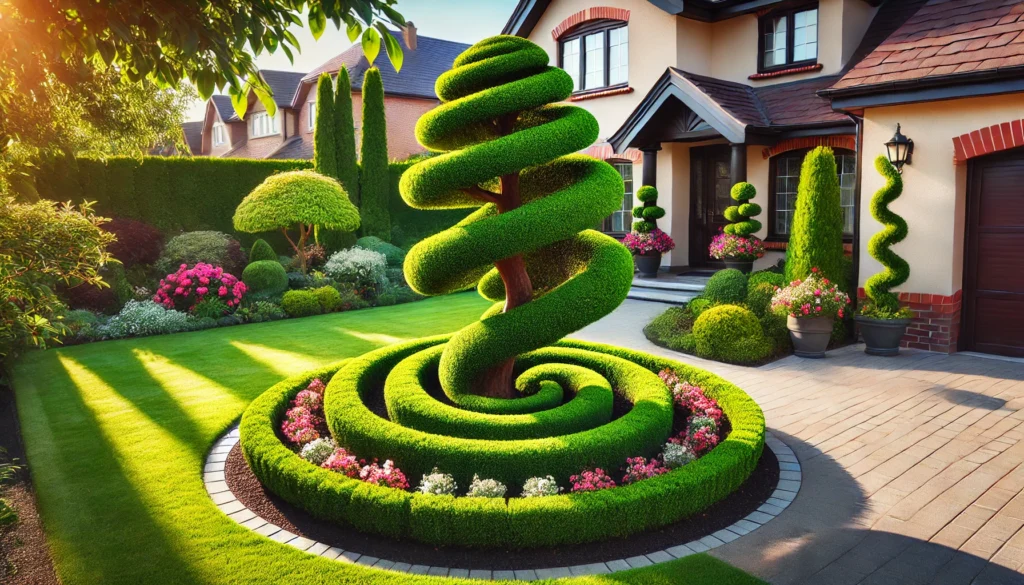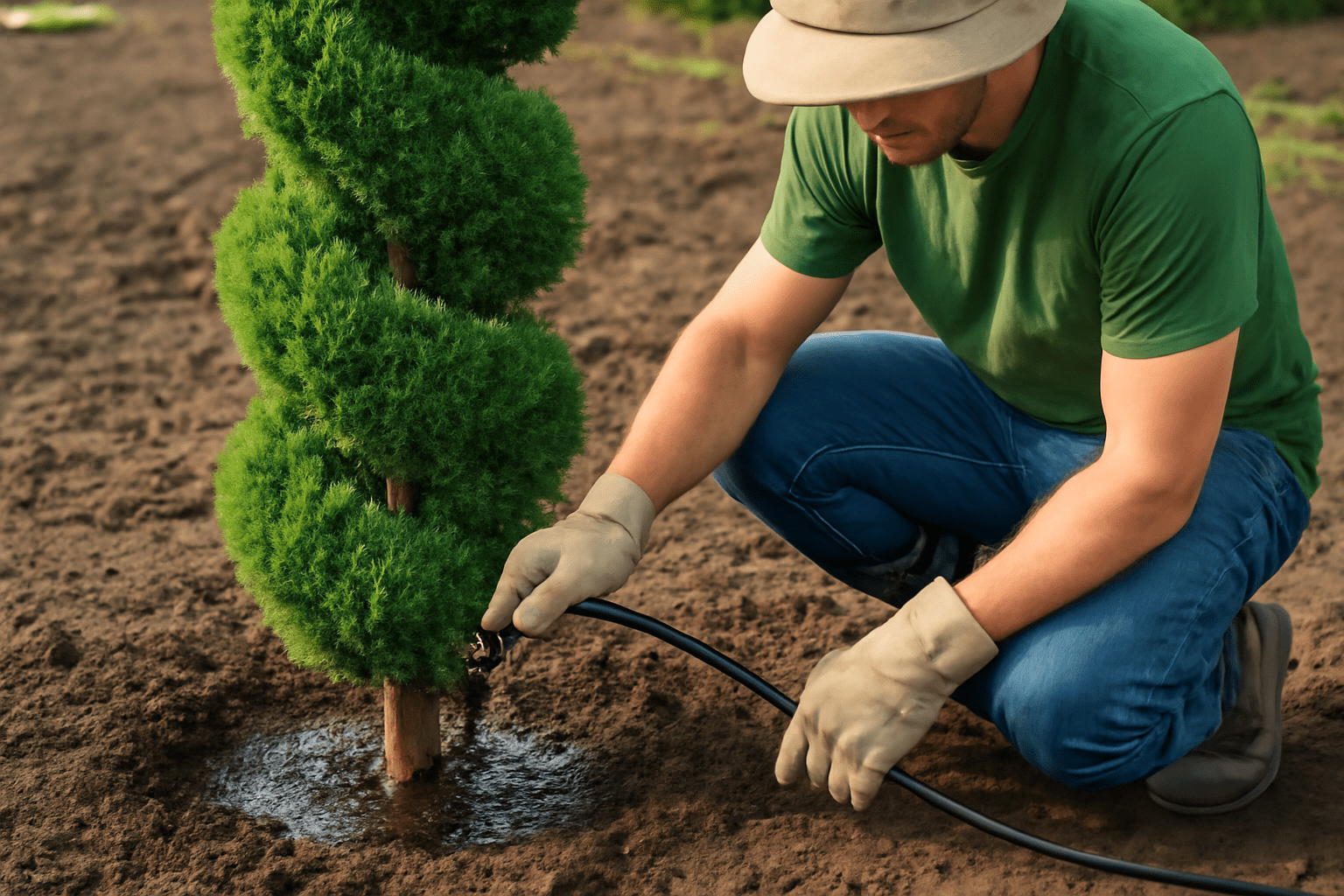
Spiral Juniper Tree Care & Design Guide: How to Grow, Shape, and Maintain This Elegant Landscape Favorite
Transform your yard into a show-stopping masterpiece with one simple addition — the spiral juniper tree 
Are you unsure how to keep your tree looking sharp, healthy, and beautifully spiraled year-round? You’re not alone. Many homeowners struggle with pruning techniques, watering routines, and seasonal care — often leading to faded greenery or lopsided spirals.
In this comprehensive care and design guide, you’ll discover exactly how to grow, shape, and maintain your spiral juniper tree like a pro — even if you’re a complete beginner. Whether you’re aiming for picture-perfect symmetry or just want to avoid common mistakes, this article is packed with proven tips, tools, and expert strategies to help your tree thrive. Keep reading to unlock the secrets behind this iconic landscape favorite!
Table of Contents
Toggle What Is a Spiral Juniper Tree?
What Is a Spiral Juniper Tree?
A spiral juniper tree is a type of evergreen shrub or small tree that has been carefully shaped into a beautiful spiral form. It’s not a different species—it’s usually a variety of Juniperus chinensis (Chinese Juniper) or Juniperus scopulorum (Rocky Mountain Juniper)—but trained over time using topiary techniques. Think of it like bonsai’s taller cousin, but for your front yard or garden entrance 

 Why the Spiral Shape?
Why the Spiral Shape?
The signature spiral design isn’t natural—it’s the result of artful pruning and training. Gardeners slowly shape the tree as it grows, guiding the branches into a twist around the central trunk. This gives the tree its iconic sculptural look that adds a formal, elegant vibe to gardens, entryways, patios, and walkways.

 Perfect for Decorative Landscaping
Perfect for Decorative Landscaping
Spiral juniper trees are a landscape favorite because they:
- Stay green year-round (hello, winter curb appeal!
)
- Add a sense of sophistication without overwhelming your space
- Work great in pots, planters, or directly in the ground
- Are drought-tolerant and low maintenance once established
They’re often used to frame doorways, line walkways, or as standalone statement pieces in formal gardens.
 Natural Beauty Meets Design
Natural Beauty Meets Design
Even though the shape is artificial, the tree itself is 100% natural. Its dense, lush foliage, slow growth, and upright habit make it ideal for training into tight forms like spirals. With proper care and annual trimming, it can hold its shape for many years, rewarding you with a living sculpture that evolves with time.
 Quick Snapshot
Quick Snapshot
Feature | Details |
Type | Evergreen, conifer, topiary-style |
Common Varieties | Juniperus chinensis, J. scopulorum |
Uses | Ornamental, landscaping, formal entrances |
Shape Origin | Created through pruning, not natural |
Growth Habit | Upright, dense foliage, slow growing |
 Final Thoughts
Final Thoughts
If you’re looking to add charm, structure, and year-round greenery to your landscape, the spiral juniper is a stylish yet beginner-friendly choice. It’s where nature meets design, and the results are nothing short of stunning 
Sure! Here’s the section titled:
 Benefits of Growing Spiral Juniper Trees
Benefits of Growing Spiral Juniper Trees
Spiral Juniper trees aren’t just a pretty addition to your garden—they’re a smart, low-maintenance way to bring year-round structure and sophistication to your outdoor space. Let’s break down why they’re worth growing
1. Stunning Visual Appeal
Spiral Junipers instantly elevate any landscape with their elegant, sculpted form. Their spiral shape creates a striking focal point in gardens, patios, or front yards—perfect for boosting curb appeal or making an entrance look grand
Whether in pots or planted in the ground, they add a touch of formal design without the need for complex landscaping.
2. Year-Round Greenery
Unlike many other ornamentals, Spiral Junipers are evergreen. That means they stay lush and vibrant through every season—even in winter!
You won’t have to worry about bare branches or dull garden patches when the cold months hit. They provide consistent color and structure all year long.
3. Low Maintenance & Hardy
These trees are tough cookies! 
With just occasional pruning to maintain their shape and minimal watering once rooted, they’re perfect for busy homeowners or beginner gardeners who still want that “wow” effect without the hassle.
4. Great for Small Spaces
Got a tight yard or a compact balcony? No problem.
Spiral Junipers grow vertically and don’t spread out much, making them ideal for containers or narrow spaces where horizontal room is limited. They offer maximum design impact with minimal footprint
5. Flexible Landscape Use
Use them solo to frame an entryway, in pairs to create symmetry, or line them along a path for a classic European garden vibe. Their versatility makes them a favorite among both DIY landscapers and pros.
6. Air Purification Bonus 
Like all green plants, Junipers help clean the air around them. While they won’t replace a forest, every bit counts—and having greenery nearby contributes to better air quality and a calming outdoor environment.
Bottom Line:
Spiral Juniper trees offer beauty, function, and ease—all rolled into one stylish package. Whether you’re dressing up your front yard or designing a serene backyard escape, these trees are a graceful, smart choice

 How to Plant a Spiral Juniper Tree (Step-by-Step)
How to Plant a Spiral Juniper Tree (Step-by-Step)
Planting a Spiral Juniper Tree is easier than you think—just follow these simple steps to set your tree up for success
1.  Choose the Right Spot
Choose the Right Spot
Spiral Junipers thrive in full sun, so pick a spot that gets at least 6 hours of direct sunlight daily. Make sure the area has well-drained soil—they don’t like soggy roots!

2.  Prepare the Planting Hole
Prepare the Planting Hole
Dig a hole that’s 2x as wide as the root ball but only as deep as the container. This gives roots room to spread out sideways without sinking the tree too low.

3.  Position the Tree
Position the Tree
Place the Spiral Juniper in the hole, making sure the top of the root ball is level with the ground. Face the spiral design toward the direction you want it to be admired from (curb appeal matters!).

4.  Backfill & Water
Backfill & Water
Fill the hole with soil, gently tamping it down to remove air pockets. Water thoroughly to help the soil settle.

5.  Mulch for Moisture
Mulch for Moisture
Add a 2–3 inch layer of organic mulch (like bark or wood chips) around the base—but keep it a few inches away from the trunk to prevent rot.

6.  Water Regularly
Water Regularly
For the first few weeks, water your Spiral Juniper deeply 2–3 times per week. Once it’s established, once a week is usually enough (depending on climate and rainfall).

7.  Stake if Needed
Stake if Needed
If your tree is tall or in a windy area, use a tree stake to keep it stable until roots anchor it fully (usually 6–12 months).
 That’s It!
That’s It!
With the right start, your Spiral Juniper Tree will flourish into a stunning focal point that elevates your landscape design

 Watering & Feeding Tips
Watering & Feeding Tips
Keeping your spiral juniper tree lush and vibrant starts with mastering the basics: proper watering and feeding. Here’s how to do it like a pro, without the guesswork
 Watering Tips: Keep It Moist, Not Mushy
Watering Tips: Keep It Moist, Not Mushy
Spiral junipers are drought-tolerant once established, but young or newly planted trees need constant watering.
- Newly Planted Trees: Water deeply 2–3 times per week for the first month. Focus on soaking the root ball—not just surface-level watering.
- Established Trees: Cut back to once every 7–10 days. Let the top 1–2 inches of soil dry out between waterings.
- Hot Weather Alert
: During heatwaves, give extra hydration to prevent stress and browning.
- Avoid Overwatering: Junipers hate soggy roots. Ensure your soil drains well and never let the tree sit in water.

 Feeding Tips: Fuel for Foliage
Feeding Tips: Fuel for Foliage
While spiral junipers aren’t heavy feeders, a little nutrition goes a long way in keeping their foliage green and their shape strong.
- When to Feed: Early spring (March–April) and optionally again in mid-fall.
- What to Use: A balanced, slow-release fertilizer (like 10-10-10 or 14-14-14) works great. You can also use evergreen-specific blends.
- How to Apply: Sprinkle granules evenly at the drip line—not directly against the trunk. Water it in to activate the nutrients.

 Quick Mistakes to Avoid
Quick Mistakes to Avoid



By getting the watering and feeding rhythm right, your spiral juniper will stay healthy, hold its elegant shape, and turn heads all year long!

 How to Shape a Spiral Juniper Tree
How to Shape a Spiral Juniper Tree
Creating a stunning spiral shape in your juniper tree may look complex, but it’s totally doable—even for beginners! With the right tools, a little patience, and a steady hand, you’ll turn a simple shrub into a gorgeous garden focal point 
 Step 1: Choose the Right Juniper
Step 1: Choose the Right Juniper
Not all junipers are created equal. Go for a dense, upright-growing variety like Blue Point or Skyrocket Juniper. These hold their shape better and respond well to pruning.
Pro tip: Pick a plant that’s at least 3 feet tall—this gives you enough height to work with and shape a visible spiral.
 Step 2: Visualize Your Spiral
Step 2: Visualize Your Spiral
Before you snip anything, imagine the spiral path wrapping around the tree. You can even use a piece of ribbon, string, or painter’s tape to mark the path from top to bottom. This will be your guide.
Think of it like peeling an apple—one long, even swirl from top to bottom 
 Step 3: Rough Cut the Spiral Path
Step 3: Rough Cut the Spiral Path
Start trimming along your marked spiral line. Don’t try to make it perfect on your first pass. Just remove the bulk of the foliage where the spiral will go, forming the “valleys” between the “ridges.”
- Use sharp hand pruners or hedge shears.
- Cut small sections at a time to avoid over-pruning.

 Step 4: Define and Clean the Edges
Step 4: Define and Clean the Edges
Now that you’ve carved the general shape, go back and sharpen the lines between the spiral’s ridges and valleys.
- Round out the ridge areas to make them more defined.
- Clean up loose branches sticking out from the spiral curve.
This stage is all about detail and balance—step back often to check your work from different angles 
 Step 5: Maintain the Shape Regularly
Step 5: Maintain the Shape Regularly
Shaping a spiral isn’t a one-and-done job. To keep it looking sharp:
- Prune 2–3 times a year, ideally in early spring, mid-summer, and late fall.
- Remove any new growth that blurs the spiral form.
- Watch for dead or brown needles and trim them away to keep it healthy.


Always sanitize your pruning tools before and after trimming to prevent disease. A quick dip in a bleach solution or rubbing alcohol does the trick 
By following these steps, you’ll not only master the art of shaping a spiral juniper but also turn your yard into a statement of style and elegance 

 Seasonal Care & Maintenance
Seasonal Care & Maintenance
Caring for your Spiral Juniper Tree throughout the year ensures it stays healthy, vibrant, and beautifully shaped. Here’s a season-by-season breakdown to help you master year-round maintenance like a pro
 Spring: Wake-Up Call for Growth
Spring: Wake-Up Call for Growth
- Pruning Time: Gently trim any winter damage and refine the spiral shape while new growth is still soft.
- Fertilize Smartly: Apply a balanced, slow-release fertilizer (10-10-10) once in early spring to jumpstart healthy foliage.
- Water Check: As temperatures rise, start watering regularly—but make sure the soil is well-drained. Overwatering = root rot
.
- Pest Patrol: Watch for aphids or spider mites. Neem oil or insecticidal soap can help, if needed.
 Summer: Growth & Protection
Summer: Growth & Protection
- Water Wisely: Deep-water your juniper every 7–10 days. More frequently during extreme heat waves
.
- Mulch Matters: A 2–3 inch layer of mulch helps retain moisture and keeps roots cool—just keep it away from the trunk.
- Shape Up: Minor touch-up pruning can keep the spiral tight and tidy—but avoid heavy cutting in peak heat.
- Inspect for Stress: Yellowing? Browning? That could mean heat stress or underwatering—adjust care accordingly.
 Fall: Prepare for Rest
Fall: Prepare for Rest
- Light Pruning: Tidy up the shape one last time before winter, but don’t overdo it.
- No Fertilizer: Stop feeding in fall—new growth won’t have time to harden before frost
.
- Pest Prevention: Remove fallen leaves and debris around the base to reduce hiding spots for overwintering pests.
- Water Before Freeze: Give one last deep watering before the ground freezes to help roots stay hydrated.
 Winter: Protect & Monitor
Winter: Protect & Monitor
- Wrap If Needed: In colder zones (USDA 4–6), consider burlap wrap to shield against windburn and heavy snow
.
- Brush Off Snow: Gently shake or brush off heavy snow to prevent branch breakage—don’t let the spiral deform!
- Minimal Watering: Water only during dry spells if temps are above freezing and the ground isn’t frozen.
- Avoid Salts: If near roads or sidewalks, shield your tree from de-icing salt spray—it can burn the foliage.
 Pro Tips Year-Round
Pro Tips Year-Round
- Use Clean Tools: Always sanitize pruners before trimming to prevent disease.
- Rotate the Pot (If Potted): Every few weeks, give the tree a turn for even sun exposure.
- Keep an Eye Out: Early detection of pests or diseases = easier treatment.
By following this seasonal plan, your Spiral Juniper Tree will thrive through all four seasons—looking sharp, staying healthy, and continuing to wow your neighbors year after year!

 Common Problems & How to Fix Them
Common Problems & How to Fix Them
Even the most elegant spiral juniper trees can face a few bumps along the way. Don’t worry—most issues are easy to fix with the right approach. Here’s a breakdown of the most common problems and simple solutions to keep your tree looking its best!
1.  Browning Foliage
Browning Foliage
Problem: Brown, dry, or crispy needles can appear due to underwatering, overwatering, poor soil drainage, or transplant shock.
Fix It:
- Check the soil—if it’s soggy or bone dry, adjust your watering.
- Water deeply but infrequently (once every 7–10 days).
- Improve drainage by adding organic matter or planting in raised beds or mounds.
- Use mulch to retain moisture and regulate temperature.

2.  Pest Infestations
Pest Infestations
Problem: Spider mites, aphids, or bagworms can infest your spiral juniper, causing yellowing, webbing, or needle drop.
Fix It:
- Inspect the tree regularly (especially undersides of branches).
- Spray with neem oil or insecticidal soap weekly until pests disappear.
- For serious cases, use horticultural oil or consult a pro.

3.  Powdery Mildew or Fungal Spots
Powdery Mildew or Fungal Spots
Problem: White powdery coatings or black/brown spots often mean fungal infections due to poor air circulation or excess moisture.
Fix It:
- Prune surrounding plants to increase airflow.
- Avoid overhead watering.
- Use a fungicide labeled safe for evergreens if needed.

4.  Misshaped or Overgrown Spirals
Misshaped or Overgrown Spirals
Problem: If your spiral loses its shape or looks wild, it likely needs pruning.
Fix It:
- Trim lightly 2–3 times a year during spring and mid-summer.
- Use sharp, clean shears to maintain the spiral outline.
- Follow the original shape closely; don’t overcut.

5.  Root Rot
Root Rot
Problem: If the plant looks sickly with drooping, discolored foliage and a mushy base, root rot might be the culprit—usually caused by poor drainage or overwatering.
Fix It:
- Dig gently around the roots to inspect—blackened, mushy roots are a red flag.
- Trim off affected roots and replant in well-draining soil.
- Water only when the top inch of soil feels dry.

6.  Sunburn or Winter Burn
Sunburn or Winter Burn
Problem: Yellow or brown patches on the sunny or wind-facing side? This could be sunburn (in hot climates) or winter burn (in cold ones).
Fix It:
- In hot zones, provide partial shade during peak sun.
- In winter, apply anti-desiccant spray or wrap the tree with burlap.
- Water well before frost to reduce winter stress.

 Final Tips
Final Tips
- Monitor your tree weekly—it’s easier to prevent than to cure.
- Keep your pruning tools clean to avoid spreading disease.
- Don’t be afraid to ask your local garden center for help if unsure.
With a little attention and care, your spiral juniper will remain the stunning centerpiece of your landscape for years to come!

 Design Ideas Using Spiral Juniper Trees
Design Ideas Using Spiral Juniper Trees
Spiral Juniper trees aren’t just plants—they’re living sculptures 
1.  Frame Your Entryway with Elegance
Frame Your Entryway with Elegance
Place one Spiral Juniper on each side of your front door, gate, or driveway entrance. This creates a symmetrical, sophisticated look that impresses guests and boosts curb appeal instantly. Use tall planters to enhance height and drama!
2.  Use Them in Container Gardens
Use Them in Container Gardens
Short on space? No problem! Spiral Junipers thrive in large containers. Use them on patios, balconies, or even rooftop gardens for a modern, minimalist vibe. Pair with trailing plants like ivy or petunias for contrast and color.
3.  Anchor Flower Beds or Borders
Anchor Flower Beds or Borders
Spiral Junipers make excellent focal points in flower beds or along garden borders. Their vertical structure draws the eye upward and adds architectural interest. Surround them with seasonal blooms or low shrubs to soften the look.
4.  Highlight Walkways & Paths
Highlight Walkways & Paths
Line walkways with evenly spaced Spiral Junipers for a clean, formal aesthetic. This technique works especially well in Mediterranean, Tuscan, or classic-style landscapes.
5.  Create a Zen or Formal Garden Feature
Create a Zen or Formal Garden Feature
Spiral Junipers pair beautifully with gravel, stone lanterns, and neatly trimmed hedges. Use them as living sculptures in Japanese-style or formal European gardens for a serene, balanced appearance.
6.  Seasonal Decor Bonus
Seasonal Decor Bonus
Spiral Junipers double as mini Christmas trees during the holidays 
Quick Design Tips:
- Keep it balanced: Use odd numbers for informal settings (1, 3, 5) and even numbers for symmetry.
- Light them up: Add garden spotlights at the base to highlight the spiral structure at night
.
- Maintain the shape: Prune regularly to keep the spiral crisp and elegant.
Spiral Juniper trees are the perfect blend of beauty and low maintenance. With just a few smart placements, you can turn an ordinary landscape into a show-stopper

 Conclusion
Conclusion
The spiral juniper tree is more than just a plant — it’s a living statement piece that brings elegance, structure, and year-round beauty to your landscape. Whether you’re shaping your very first spiral or maintaining an established showpiece, the right care routine can make all the difference between a struggling shrub and a thriving garden feature.
From choosing the perfect planting spot and shaping clean, symmetrical curves to watering wisely and preventing common issues, you’ve now got a complete toolkit to care for and design with confidence. Even if you’re a beginner, don’t be intimidated — spiral junipers are surprisingly resilient once established, and each trim brings you closer to mastering the art.

Remember, consistency is key. With just a little attention each season, your spiral juniper can stay healthy, lush, and perfectly sculpted — turning heads and elevating curb appeal for years to come.
Frequently Asked Questions(FAQ)
How often should I trim a spiral juniper tree?
Trim your spiral juniper 2–3 times per year to maintain its shape, ideally in late spring and mid-to-late summer. Regular light pruning prevents overgrowth and keeps the spiral crisp and clean without stressing the plant.
Can I shape a spiral juniper tree myself, or do I need a professional?
You can absolutely shape a spiral juniper tree yourself — even as a beginner. Use twine to mark a spiral guide, then carefully trim along it using sharp pruning shears. Start slow and practice with light cuts until you’re confident.
Why is my spiral juniper turning brown?
Browning can be caused by underwatering, overwatering, poor drainage, pests, or winter burn. Check the soil moisture and inspect for pests like spider mites, then adjust your care routine or prune affected branches to encourage recovery.
How much sunlight does a spiral juniper tree need?
Spiral juniper trees thrive in full sun, meaning they need at least 6–8 hours of direct sunlight each day. Too much shade can lead to sparse growth and a less defined spiral shape.
Can I grow a spiral juniper in a pot or container?
Yes, spiral junipers grow well in large pots with good drainage. Use a high-quality potting mix and place the container in full sun. Container-grown junipers may need more frequent watering and occasional root pruning.
What type of soil is best for spiral juniper trees?
They prefer well-draining soil, such as sandy or loamy mixes. Avoid heavy clay or waterlogged areas, as poor drainage can cause root rot and other health problems.
Do spiral junipers need fertilizer?
Yes, apply a balanced, slow-release fertilizer in early spring to support healthy growth. Avoid over-fertilizing, as too much nitrogen can cause excessive growth that ruins the spiral form.
Are spiral juniper trees low maintenance?
Yes, once established, spiral junipers are drought-tolerant and require minimal care beyond occasional watering and seasonal pruning. They’re a great choice for homeowners who want elegant landscaping with less work.







